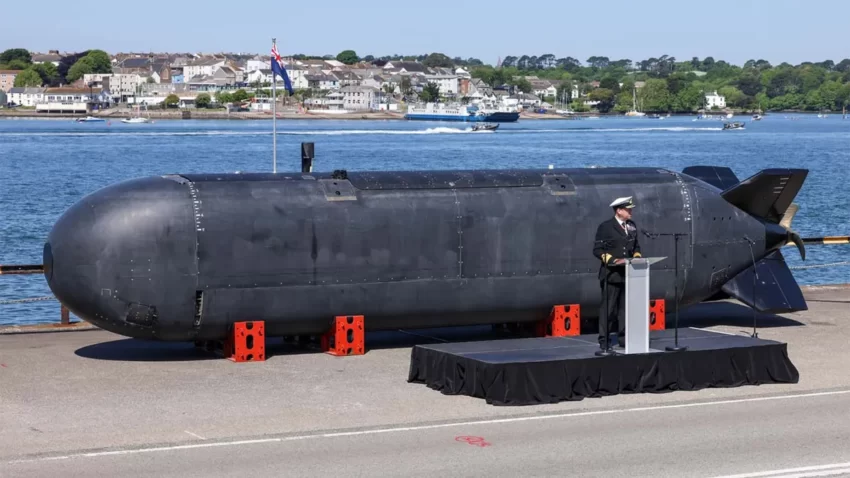
UK S Royal Navy Tests 40-foot Submarine
A new submarine drone, named Excalibur, has been successfully tested by the UK’s Royal Navy and can be operated remotely from significant distances.
Introduction to Excalibur
The UK’s Royal Navy has recently made headlines with its latest technological advancement in underwater warfare and reconnaissance. The Excalibur, a 40-foot submarine drone, represents a significant leap in naval capabilities, allowing for remote operation from potentially thousands of miles away. This innovation not only enhances the Royal Navy’s operational flexibility but also sets a new standard for unmanned underwater vehicles (UUVs) globally.
The Design and Features of the Excalibur
The Excalibur is designed to be a versatile tool for various naval operations. Here are some of its key specifications and features:
- Length: 40 feet
- Control Range: Operable from ‘the other side of the world’
- Submersion Capability: Can be controlled while submerged
- Applications: Reconnaissance, surveillance, and potentially offensive operations
One of the most remarkable aspects of the Excalibur is its ability to be controlled remotely while submerged. This feature significantly reduces the risk of detection, allowing for covert operations that are critical in modern naval warfare. The drone is equipped with advanced sensors and communication systems that facilitate real-time data transmission, ensuring that operators can maintain situational awareness even from great distances.
Technological Innovations Behind Excalibur
The development of the Excalibur involved cutting-edge technology that integrates artificial intelligence (AI) and machine learning. These technologies enable the drone to process vast amounts of data and make autonomous decisions based on its programming and environmental conditions. This capability is particularly useful in complex underwater environments where human operators may struggle to respond quickly to changing situations.
Additionally, the drone’s design incorporates advanced materials that enhance its durability and stealth. The use of composite materials allows the Excalibur to withstand the harsh conditions of underwater operations while minimizing its radar and sonar signatures, making it less detectable to enemy forces.
Strategic Implications for the Royal Navy
The introduction of the Excalibur drone marks a pivotal moment for the Royal Navy, reflecting a broader trend among military organizations worldwide to integrate unmanned systems into their operations. The ability to operate a submarine drone from such distances could have several strategic implications:
- Enhanced Surveillance: The Excalibur can be deployed for extended periods, providing continuous surveillance capabilities in key maritime areas.
- Reduced Risk to Personnel: By utilizing unmanned systems, the Royal Navy can minimize the risk to human life during potentially dangerous missions.
- Increased Operational Flexibility: The drone’s ability to be controlled remotely allows for rapid deployment and response to emerging threats.
Comparative Analysis with Other Unmanned Systems
The Excalibur is not the first unmanned underwater vehicle to be developed, but its capabilities set it apart from existing systems. For instance, other military organizations, such as the United States Navy, have been working on similar technologies, including the Navy’s Orca and the Lockheed Martin’s Marlin. However, the Excalibur’s unique ability to operate from vast distances while submerged offers a distinct advantage.
Potential Applications Beyond Military Use
While the primary focus of the Excalibur is military operations, its technology has potential applications in various civilian sectors. For instance, the energy industry could utilize such drones for underwater inspections of oil pipelines and offshore wind farms. Additionally, environmental monitoring efforts could benefit from the drone’s capabilities in assessing underwater ecosystems and tracking marine life.
Future Developments and Expectations
The Royal Navy’s successful testing of the Excalibur is just the beginning. As technology continues to evolve, further enhancements are expected to be integrated into the drone. Future iterations may include improved AI capabilities, enhanced data processing, and even greater operational ranges.
Moreover, the Royal Navy is likely to collaborate with technology companies and research institutions to refine the Excalibur’s design and functionality. Such partnerships could accelerate the development of new features, making the drone an even more formidable tool in naval operations.
Public and Governmental Response
The unveiling of the Excalibur has sparked discussions among defense analysts, military strategists, and policymakers. Many view this development as a necessary step in modernizing the Royal Navy’s capabilities in response to evolving global threats. The UK government has also expressed its commitment to investing in advanced technologies to maintain a competitive edge in defense.
However, there are concerns regarding the ethical implications of deploying unmanned systems in military operations. Questions about accountability, decision-making, and the potential for autonomous warfare are being raised as the technology becomes more prevalent. It is crucial for governments and military organizations to establish clear guidelines and frameworks to address these challenges.
Conclusion
The Excalibur submarine drone represents a significant advancement in naval technology, showcasing the UK’s commitment to innovation in defense. Its ability to be operated remotely from great distances while submerged opens up new possibilities for military and civilian applications alike. As the Royal Navy continues to test and refine this technology, the implications for both national security and global maritime operations will be profound.
As the landscape of naval warfare evolves, the Excalibur may well become a cornerstone of modern military strategy, influencing how nations approach underwater operations and shaping the future of defense technology.
uk s royal navy tests 40-foot submarine — Source: Original reporting.
uk s royal navy tests 40-foot submarine — Source: Original reporting.
Source: Original reporting
Further reading: related insights.
Was this helpful?
Last Modified: August 18, 2025 at 4:09 am
5 views














